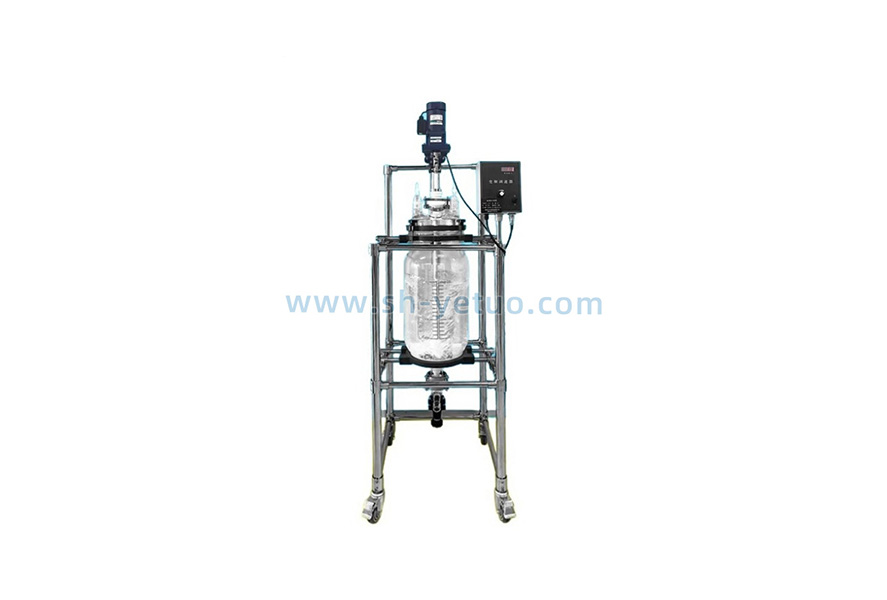The operation of Shanghai Yetuo double-layer glass reaction kettle needs to follow rigorous steps to ensure the safety of experiments or production and the stability of reaction effects. The specific process can be divided into five steps: preparation before operation, material feeding, stirring start-up, temperature and pressure control, and post-treatment after reaction:
1、 Preparation before operation
Equipment status check: First confirm that the main power supply, cooling water pipeline, and vacuum pipeline switches of the reaction kettle are all in the closed state to avoid misoperation. Check the high borosilicate glass kettle body, observe through light transmission and lightly tap the sound (crisp is normal, dull may have cracks), to ensure that there are no cracks or scratches; Check the sealing rubber ring (made of silicone rubber or fluororubber material). If there is aging, deformation, or damage, it should be replaced in a timely manner. At the same time, check whether the connection between the stirring blade and the motor shaft is firm, manually rotate the stirring blade, and confirm that there is no jamming or friction on the kettle wall; Calibration measuring tools, such as electronic scales, need to be zeroed for calibration, and measuring cylinders and pipettes need to be undamaged and have clear scales.
Material and tool preparation: Verify the name, purity, and status of the reactants to ensure no deterioration or contamination. If pre-treatment of the materials is required (such as solid grinding or liquid dilution), it should be done in a clean container. The diameter of the solid particles after grinding should not exceed 5mm to avoid blocking the pipeline or scratching the kettle body. Prepare the necessary tools, such as clean glass rods, spoons, brushes, and compatible temperature control media (cold water, hot water, or thermal oil), to ensure that the temperature control media is clean and free of impurities.
2、 Material deployment
Open the kettle lid: Hold the handles on both sides of the kettle lid with both hands and slowly lift it vertically upwards to avoid collision between the kettle lid and the edge of the kettle body. Place the kettle lid steadily on a workbench with clean rubber pads to prevent scratches or impurities on the surface of the kettle lid.
Material addition: When adding liquid materials, use a calibrated measuring cylinder or pipette and slowly pour them along the wall of the kettle. If the viscosity of the material is high, use a dry and clean glass rod to drain the water and avoid splashing the material; When adding solid materials, slowly add them into the kettle with a clean spoon. If there are block shaped materials, they should be crushed first. It is forbidden to throw solid materials from high altitude to prevent them from hitting the bottom of the kettle and causing glass damage. If the material sticks to the wall of the kettle, gently sweep it into the bottom of the kettle with a clean brush to avoid residue.
Closure of kettle lid: After the material is placed, check again that there are no foreign objects or impurities inside the kettle. Hold the kettle lid with both hands and slowly close it to ensure that the sealing interface between the kettle lid and the kettle body is aligned. Gently press the edge of the kettle lid to make the sealing rubber ring tightly fit and prevent leakage in subsequent reactions.
3、 Start up and adjustment of mixing system
Confirmation before startup: Turn on the main power switch of the reaction kettle, do not start the mixing first, observe whether the equipment indicator light is normal, and confirm that the power cord of the mixing motor is firmly connected and not damaged.
Mixing start and speed regulation: Adjust the mixing speed knob to the lowest gear (50-100r/min), start the mixing motor, observe the rotation status of the mixing blade, ensure that there is no abnormal vibration or noise, and that the mixing blade does not touch the kettle wall. Run at low speed for 5 minutes. If there are no abnormalities in the equipment, slowly adjust the speed according to the viscosity of the material and reaction requirements. The increase in speed should not exceed 100r/min each time to avoid material splashing or motor overload caused by sudden speed increases. If the viscosity of the material increases during the reaction process (such as generating viscous products), the speed should be reduced in a timely manner to prevent the stirring blade from breaking or the motor from being damaged.
4、 Temperature and pressure control
Temperature control operation: Set the target temperature according to the reaction process requirements, check that the temperature control system pipeline is tightly connected and leak free, insert the temperature sensor into the middle of the material in the kettle (avoid contact with the kettle wall or stirring blade), and ensure accurate temperature detection. Turn on the power of the temperature control system, start the temperature control medium circulation pump, and control the temperature rise and fall rate to 5-10 ℃/h to avoid sudden temperature changes that may cause damage to the kettle body due to thermal expansion and contraction. If using high-temperature medium (temperature>100 ℃), insulation cotton should be wrapped around the outer layer of the pipeline; When using low-temperature media (such as frozen salt water), operators need to wear anti low temperature gloves.
Pressure control operation: If the reaction needs to be carried out in a negative or positive pressure environment, slowly open the vacuum valve or inert gas valve, observe the pressure instrument, and adjust the pressure to within 80% of the rated pressure of the equipment (usually negative pressure not lower than -0.1MPa, positive pressure not higher than 0.1MPa). Monitor pressure changes throughout the process. If there is a sudden increase or decrease in pressure, immediately close the valve, check if the pipeline is blocked, and if the seal is ineffective. Continue operating after the problem is resolved.
5、 Post reaction processing
Equipment shutdown: After the reaction is complete, first turn off the stirring motor, then turn off the temperature control system and temperature control medium circulation pump. After the temperature inside the reactor drops to room temperature (<40 ℃) and the pressure returns to normal pressure, turn off the main power supply, cooling water pipeline, and vacuum pipeline switches of the reactor. If there are volatile toxic materials in the kettle, toxic gases need to be discharged through the tail gas treatment device before proceeding with subsequent operations.
Material removal and equipment cleaning: Slowly open the kettle lid, tilt the kettle body and pour the reaction product into a clean container. If there is any material residue, soak it in a solvent compatible with the residual material (such as ethanol for oily residue and dilute sodium carbonate solution for acidic residue) for 10-15 minutes. Gently clean the inside of the kettle body with a soft bristled brush, rinse it three times with deionized water, and then dry it with a clean cloth or invert it to drain the water. After removing and cleaning the sealing gasket, let it dry and apply a small amount of silicone grease for maintenance. If it is damaged, replace it in a timely manner.
Equipment organization: Clean the experimental table, return the measuring tools and equipment to their original positions, record the usage of the equipment (such as reaction parameters and equipment status), and ensure that the equipment is in good condition for the next operation.


 Alibaba Store
Alibaba Store Tmall Store
Tmall Store Jingdong Sstore
Jingdong Sstore







